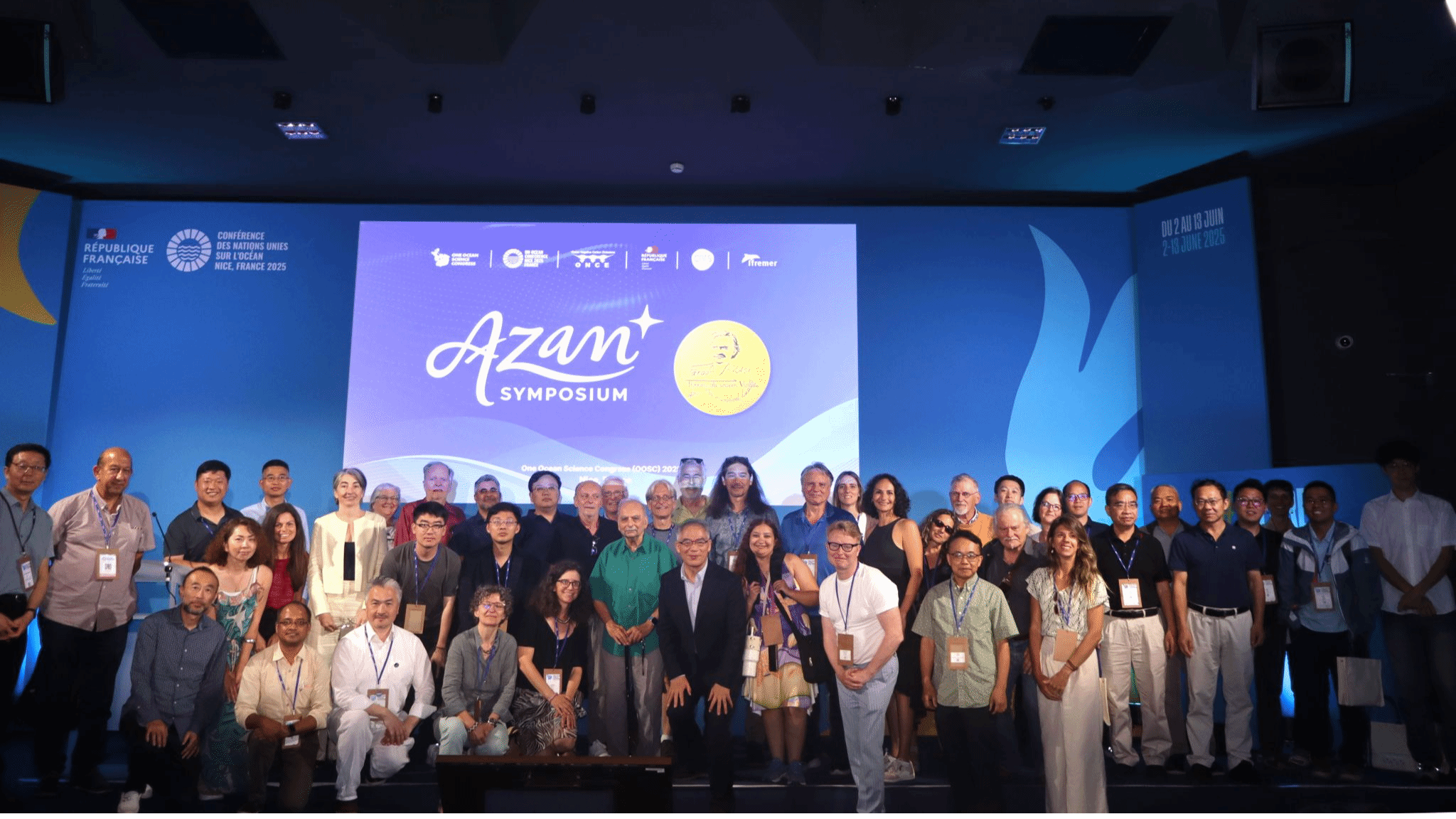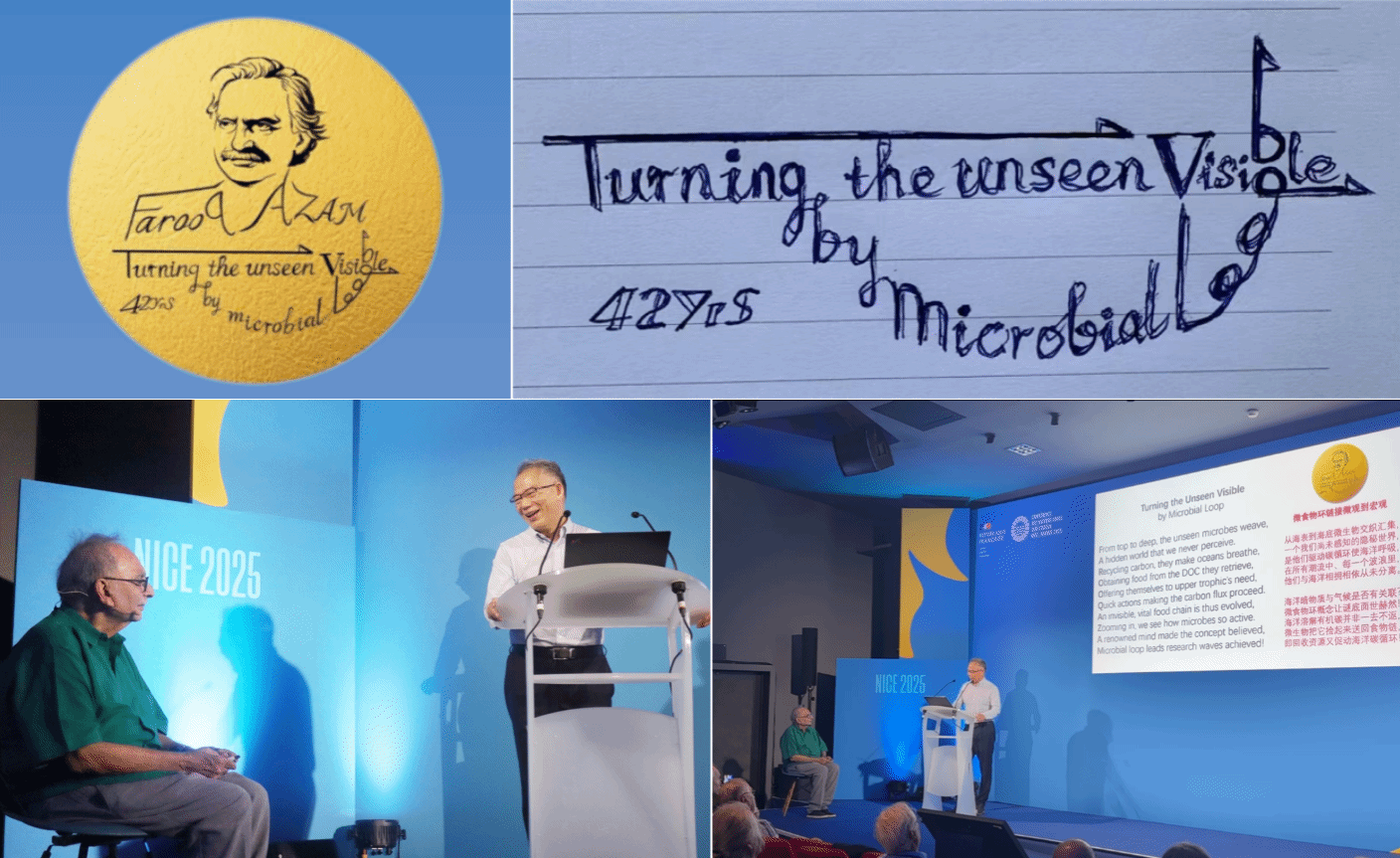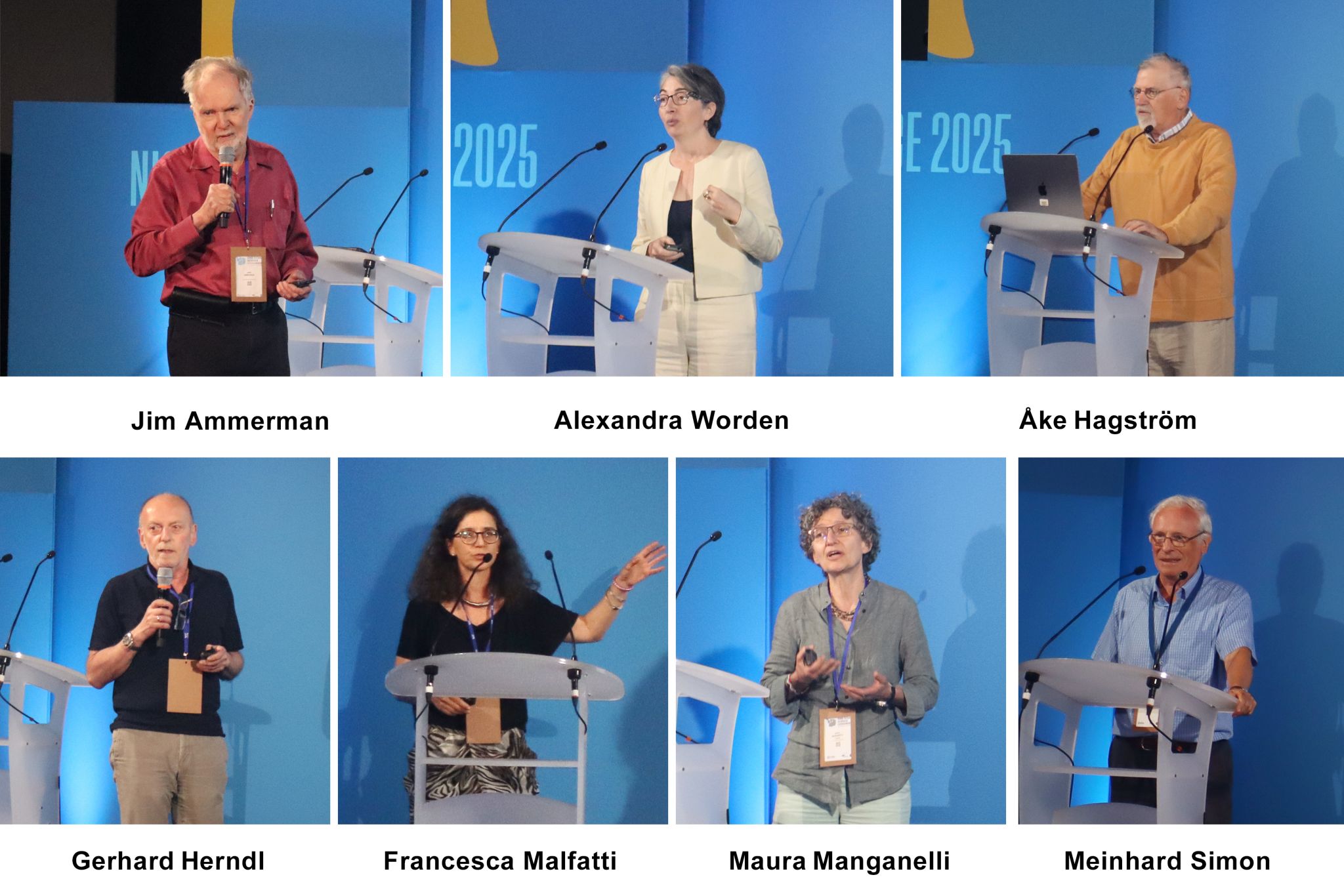Nice, France – June 5, 2025 – During the One Ocean Science Congress (OOSC), the Azam Symposium, organized by Global ONCE, was held at the "La Baleine" Auditorium. The event was chaired by Professor Chuanlun Zhang, Chair Professor at Southern University of Science and Technology and Director of the International Cooperation Department of Global ONCE. It focused on revolutionary advances in marine ecology, exploring how three key theoretical paradigms: the Biological Carbon Pump, the Microbial Loop, and the Microbial Carbon Pump (MCP), are reshaping the study of oceanic carbon cycles. The symposium also served as a tribute to Professor Farooq Azam, a leading figure in marine microbiology, honoring his invaluable contributions that have significantly shaped the field.

Half a Century of Exploration: Honoring Azam's Foundation of the Microbial Carbon Cycle Theory
In his keynote speech, Professor Farooq Azam, at 85 years old, reflected on his fifty-year scientific career, particularly revisiting his groundbreaking "Microbial Loop" theory proposed in 1983. This original theory, which explains how marine microorganisms convert dissolved organic carbon into particulate carbon, has been cited over 7,000 times and remains a milestone in ocean carbon cycle research. Azam recounted the shift from the traditional understanding of the "macro-organism-driven ocean carbon cycle" to the innovative microbial-driven carbon pump theory, resonating with scholars in the room and sparking discussions on the paradigm shift in marine ecological research.
Prof. James Ammerman, a marine ecologist from Stony Brook University, paid tribute to Azam’s academic contributions during the ceremony, summarizing his three core achievements:
1. Technological Innovation: Pioneering the use of epifluorescence microscopy to directly observe marine bacteria, overcoming the limitations of traditional cultivation methods.
2. Theoretical Foundation: Publishing the seminal paper "The Microbial Loop" in 1983, establishing a three-dimensional microbial model that highlighted its central role in the carbon cycle.
3. Mentorship Legacy: Training numerous internationally recognized scholars, including Jed A. Fuhrman, a leading figure in microbial oceanography. Azam’s innovative microbial observation techniques have also expanded into applications such as aquaculture water quality monitoring.
Ammerman concluded with Azam’s reflection: "The true academic legacy lies in training researchers who surpass their mentors," emphasizing the importance of scientific continuity.

Forty-Two Years of Scholarly Affiliation: The Academic Resonance and Legacy of Jiao Nianzhi and Azam
As a close academic partner of Azam for over 42 years, Professor Jiao Nianzhi, Chief Scientist of Global ONCE, personally designed the event's logo and commemorative badge. The design subtly incorporated elements of the "Microbial Loop" concept, along with the phrase "Turning the unseen visible," symbolizing both the significance of the theory and their 42-year-long academic journey since 1983. The logo pays tribute to Professor Farooq Azam, showcasing the critical role of microorganisms in the carbon cycle and their profound impact on climate change. In addition, Professor Jiao Nianzhi honored Azam’s contributions with an acrostic poem, which was met with unanimous praise from the guests present.

Multidimensional Interactions: Analyzing the Interplay of Carbon Cycle Mechanisms
The symposium focused on the critical role of microorganisms in global ecosystems, offering cutting-edge discussions from molecular mechanisms to atmospheric interactions:
1. Microbial Regulation in the Carbon Cycle
Prof. James Ammerman systematically explained the microbial metabolic activities involved in the transformation and migration of phosphorus, revealing how phosphorus budget imbalances could potentially affect carbon sinks.
2. Marine Plankton and Organic Carbon Transport
Prof. Alexandra Worden's groundbreaking experiments showed that small plankton in surface oceans could rapidly sink and transport organic carbon—often deemed degradable—to the deep sea, challenging the traditional view that deep-sea carbon primarily comes from inert organic matter.
3. Bacterial Membrane Transporters as Carbon "Gatekeepers"
Prof. Åke Hagstrom discussed the pivotal function of bacterial membrane transport proteins as "carbon keepers," explaining how they regulate carbon absorption pathways by specifically binding to organic molecules, providing a theoretical foundation for developing genome-driven biogeochemical models.
4. Deep-sea Microbial Carbon Metabolism
Prof. Gerhard Herndl revealed the phenomenon of "dark primary production" in deep-sea microbes, with certain strains performing heterotrophic activities (dark primary production) to fix CO2 at depths of 2700 meters. This finding, combined with non-settling particulate organic carbon evidence, reshapes our understanding of deep-sea carbon metabolism.
5. Microalgae and Antibiotic Resistance in Wastewater
Prof. Maura Manganelli confirmed that blue algae in wastewater could transfer antibiotic resistance genes and increase toxin transfer efficiency through gene transfer processes.
6. Cross-layer Interactions and Ecological Safety
In the realm of cross-layer interactions and ecological safety, Prof. Francesca Malefati found that active bacteria in Sea Spray Aerosols (SSA) can survive in the atmosphere for over 24 hours. Through enzymatic reactions such as proteases, these bacteria altered aerosols’ chemical composition and increased particle collision probabilities (up to 65% within 24 hours), thus enhancing the long-range transmission of pollutants. Furthermore, ice-nucleating proteins from marine microbes can induce ice formation at temperatures below -16°C, affecting cloud precipitation processes. Future research directions include: Integrating transporter dynamics to build carbon cycle models; Tracing the transmission paths of antibiotic resistance genes in cyanobacteria; Quantifying the contributions of marine-atmosphere microbial fluxes to climate regulation.
7. Enzymatic Complexity and Carbon Persistence: Unpacking Degradation Barriers in Coastal Systems
Professor Meinhard Simon discussed enzyme-hybrid reactions and the role of polysaccharides in resisting degradation. His future research will focus on carbon cycle modeling, tracking antibiotic resistance gene transmission, and quantifying marine-atmosphere microbial fluxes, providing new insights for coastal ecological management and antibiotic pollution control.

Cross-Generational Legacy: Inspiring the Ocean Science Mission and Vision
From the groundbreaking "Microbial Loop" theory proposed by Azam’s team half a century ago, which revolutionized the traditional view that macro organisms dominate the carbon cycle, to the development of the “Microbial Carbon Pump” theory by Prof. Jiao, which further elucidates the crucial role of marine microorganisms in the sequestration of inert organic carbon, countless pioneers have contributed to the theoretical foundation of marine carbon cycle research. These scientific endeavors vividly demonstrate how fundamental research is reshaping human understanding of ocean ecology. Addressing the global challenge of climate change, the symposium emphasized that marine microbiology research is now transitioning from the laboratory to real-world applications. From the “dark primary production” mechanisms of deep-sea microbes to the role of microorganisms in sea fog aerosols influencing cloud precipitation, these discoveries are reshaping our understanding of the ocean's pivotal role in climate governance. In his closing remarks, the chair expressed, "We look forward to these pioneering works inspiring the next generation of scientists to continue exploring the microcosm of the ocean carbon cycle, providing scientific solutions for the Earth's sustainable development and lighting a new path in the fight against climate change."